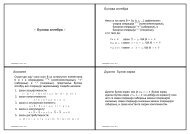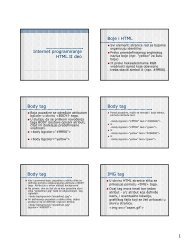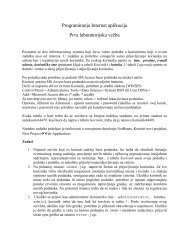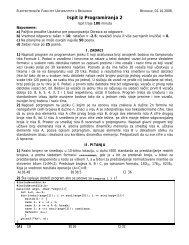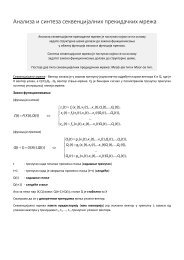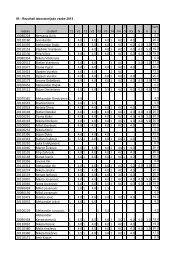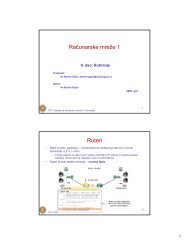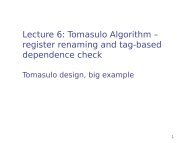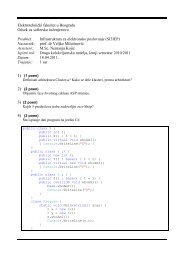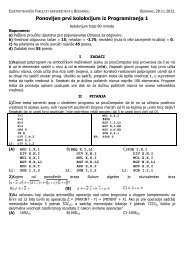WAN tehnologije WAN mreže WAN Technology WAN Technology
WAN tehnologije WAN mreže WAN Technology WAN Technology
WAN tehnologije WAN mreže WAN Technology WAN Technology
You also want an ePaper? Increase the reach of your titles
YUMPU automatically turns print PDFs into web optimized ePapers that Google loves.
<strong>WAN</strong> mreže<strong>WAN</strong> <strong>tehnologije</strong>•Računarske mreže koje obuhvatajuneograničen geografski prostor, sapropusnim opsegom reda 10 kbps do 10Gbps<strong>WAN</strong> <strong>Technology</strong><strong>WAN</strong> <strong>Technology</strong>• A <strong>WAN</strong> is a data communications network that operatesbeyond the geographic scope of a LAN.• One primary difference between a <strong>WAN</strong> and a LAN is that acompany or organization must subscribe to an outside <strong>WAN</strong>service provider in order to use <strong>WAN</strong> carrier network services.• Devices on the subscriber premises are called customerpremises equipment (CPE). The subscriber owns the CPE orleases the CPE from the service provider.• A copper or fiber cable connects the CPE to the serviceprovider’s nearest exchange or central office (CO).• This cabling is often called the local loop, or "last-mile".
<strong>WAN</strong> Service ProvidersDTE and DCEDTE and DCE<strong>WAN</strong> <strong>tehnologije</strong>• In order for the local loop to carry data, a device such asa modem is needed to prepare the data for transmission.• Devices that put data on the local loop are called datacircuit-terminating equipment, or data communicationsequipment (DCE).• The customer devices that pass the data to the DCE arecalled data terminal equipment (DTE).• The DCE primarily provides an interface for the DTE intothe communication link on the <strong>WAN</strong> cloud.• The DTE/DCE interface uses various physical layerprotocols, such as High-Speed Serial Interface (HSSI)and V.35. These protocols establish the codes andelectrical parameters the devices use to communicatewith each other.• Layer 1 (RS-232, RS-449, X.21, V.35,G.703 itd.)• Layer 2 (HDLC, PPP, Frame Relay, X.25)• Multilayer (ISDN, ATM, SDH/SONET)
Layer 1 <strong>WAN</strong> prenos• Preko <strong>WAN</strong> linkova bitovi se prenoseserijski (serijski linkovi)• Tipovi serijskih linkova– sinhroni link (trenutno do 10 Gbps)– asinhroni link (do 115200 bps)Layer 1 <strong>WAN</strong> standardi• Definišu električni interfejs za prenosbitova između DTE i DCE uređaja• Dve vrste prenosa bitova:–Sa zajedničkom masom• RS-232 (V.24, V.28, V.10)•X.21– Diferencijalni•V.35• RS-449 (RS-530, V.11)Physical Layer ConnectorsPhysical Layer: <strong>WAN</strong>s
<strong>WAN</strong> Line Types andBandwidth<strong>WAN</strong> DevicesCSU/DSUModem Transmission• The communications link needs signals in an appropriate format.• For digital lines, a channel service unit (CSU) and a data service unit (DSU)are required. The two are often combined into a single piece of equipment,called the CSU/DSU. The CSU/DSU may also be built into the interface card inthe router.• A modem is needed if the local loop is analog rather thandigital.• Modems transmit data over voice-grade telephone linesby modulating and demodulating the signal.• The digital signals are superimposed on an analog voicesignal that is modulated for transmission.• The modulated signal can be heard as a series ofwhistles by turning on the internal modem speaker.• At the receiving end the analog signals are returned totheir digital form, or demodulated.
Modem TransmissionCommunication Server• Communication servers concentrate dial-inuser communication and remote access toa LAN. They may have a mixture of analogand digital (ISDN) interfaces and supporthundreds of simultaneous users.<strong>WAN</strong> Standards• <strong>WAN</strong>s use the OSI reference model, but focus mainly on Layer1 and Layer 2.• <strong>WAN</strong> standards typically describe both physical layer deliverymethods and data link layer requirements, including physicaladdressing, flow control, and encapsulation.• <strong>WAN</strong> standards are defined and managed by a number ofrecognized authorities.HDLC• Layer 2 tehnologija koja omogućujeprenos Layer 3 datagrama preko sinhroneserijske linije• Postoji HDLC ISO standard koji nepodržava više Layer 3 protokola• Proizvođači su razvili sopstvenenekompatibilne HDLC derivate
Format HDLC okviraHDLC Fields - 10x7E10x7E1Address10x0F ili0x8F1Standardni HDLC formatControl Data10-1500Cisco HDLC format0x00 Protocol Data1 2 0-1500FCS2FCS10x7E10x7E1• The frame always starts and ends with an 8-bitflag field, the bit pattern 01111110.• Because there is a likelihood that this pattern willoccur in the actual data, the sending HDLCsystem always inserts a 0 bit after every five 1s inthe data field, so in practice the flag sequence canonly occur at the frame ends. The receivingsystem strips out the inserted bits.• When frames are transmitted consecutively theend flag of the first frame is used as the start flagof the next frame.HDLC Fields - 2HDLC Encapsulation• The address field is not needed for <strong>WAN</strong> links, which are almost alwayspoint-to-point. The address field is still present and may be one or twobytes long.• The control field indicates the frame type, which may be information,supervisory, or unnumbered:• Unnumbered frames carry line setup messages.• Information frames carry network layer data.• Supervisory frames control the flow of information frames and request dataretransmission in the event of an error.• The control field is normally one byte, but will be two bytes for extendedsliding windows systems. Together the address and control fields arecalled the frame header. The encapsulated data follows the controlfield.• Then a frame check sequence (FCS) uses the cyclic redundancy check(CRC) mechanism to establish a two or four byte field
<strong>WAN</strong> Data-Link Protocols<strong>WAN</strong> Link OptionsCircuit SwitchingPacket Switching
Point-to-Point Protocol (PPP)PPP Layered Architecture• Layer 2 tehnologija koja omogućujeprenos Layer 3 datagrama preko sinhronei asinhrone serijske linije• Komponente PPP protokola:– Enkapsulacija datagrama preko serijskoglinka– Link Control Protocol (LCP)– Network Control Protocols (NCP)Format PPP okviraLCP protokol0x7E10xFF1Format PPP okvira0x03 Protocol Data1 1(2) 0-1500FCS1(2)0x7E1• Uspostavljanje linka•Određivanje kvaliteta linka (echo reply iecho request)• Uspostavljanje algoritma kompresije• Autentifikacija (PAP i CHAP protokoli)• Uspostavljanje NCP protokola• Terminacija linka• PPP Callback
PPP algoritmi kompresije• STAC• Predictor• Microsoft Point-to-Point Compression(MPPC)Metode PPP autentifikacije• Password Authentication Protocol (PAP)– Klijent šalje korisničko ime i lozinku u čistom tekstu, ito samo na početku uspostavljanja sesije• Challenge Authentication Protocol (CHAP)– Server šalje challenge– Klijent vraća vrednost izračunatu unapred poznatimalgoritmom (MD5)– Server i sam računa tu vrednost, i poredi sadobijenomPPP Multilink• Mehanizam kojim se više fizičkih serijskihveza spajaju u jednu logičku• Svaki datagram se deli na delove fiksneveličine koji se naizmenično šalju prekosvakog od serijskih linkovaNCP protokoli• Protokoli koji razmenjuju informacije namrežnom nivou• Primeri– IPCP (razmenjuje IP adrese krajeva linka, IPadrese DNS servera itd.)– IPXCP– CDPCP
PPP Frame Fields• Flag – Indicates the beginning or end of a frame and consists of thebinary sequence 01111110.• Address – Consists of the standard broadcast address, which is thebinary sequence 11111111. PPP does not assign individual stationaddresses.• Control – 1 byte that consists of the binary sequence 00000011, whichcalls for transmission of user data in an unsequenced frame. Aconnection-less link service similar to that of Logical Link Control (LLC)Type 1 is provided.• Protocol – 2 bytes that identify the protocol encapsulated in the datafield of the frame.• Data – 0 or more bytes that contain the datagram for the protocolspecified in the protocol field. The end of the data field is found bylocating the closing flag sequence and allowing 2 bytes for the framecheck sequence (FCS) field. The default maximum length of the datafield is 1,500 bytes.• FCS – Normally 16 bits or 2 bytes that refers to the extra charactersadded to a frame for error control purposes.Establishing a PPP Session• PPP session establishment progresses through threephases.– link establishment,– authentication,– network layer protocol phase.• LCP frames are used to accomplish the work of each ofthe LCP phases. The following three classes of LCPframes are used in a PPP session:• Link-establishment frames are used to establish andconfigure a link.• Link-termination frames are used to terminate a link.• Link-maintenance frames are used to manage anddebug a link.PPP Session - Linkestablishmentphase• Link-establishment phase• each PPP device sends LCP frames to configure and test the datalink. LCP frames contain a configuration option field that allowsdevices to negotiate the use of options such as the– maximum transmission unit (MTU),– compression of certain PPP fields,– link-authentication protocol.• If a configuration option is not included in an LCP packet, the defaultvalue for that configuration option is assumed.• Before any network layer packets can be exchanged, LCP must firstopen the connection and negotiate the configuration parameters.• This phase is complete when a configuration acknowledgmentframe has been sent and received.PPP Session - Authenticationphase• Authentication phase (optional) – After the link has beenestablished and the authentication protocol decided on,the peer may be authenticated. Authentication, if used,takes place before the network layer protocol phase isentered. As part of this phase, LCP also allows for anoptional link-quality determination test. The link is testedto determine whether the link quality is good enough tobring up network layer protocols.
PAP - Password AuthenticationProtocolCHAP - Challenge HandshakeAuthentication ProtocolPPP Session - Network layerprotocol phaseFrame Relay• Network layer protocol phase –• PPP devices send NCP packets to choose and configureone or more network layer protocols, such as IP.• Once each of the chosen network layer protocols hasbeen configured, packets from each network layerprotocol can be sent over the link.• If LCP closes the link, it informs the network layerprotocols so that they can take appropriate action.• Layer 2 tehnologija koja omogućujeprenos Layer 3 datagrama preko jednefizičke veze na više različitih destinacija• Svaki uređaj u Frame relay mreži (DTE)se priključuje na Frame relay svič (DCE)preko jedne serijske veze, a uspostvljaviše logičkih veza prema drugim DTEuređajima preko virtuelnih veza (VC)
Introducing Frame RelayFrame Relay Operation• Frame Relay is an International TelecommunicationUnion Telecommunications Standardization Sector (ITU-T) and American National Standards Institute (ANSI)standard.• Frame Relay is a packet-switched, connection-oriented,<strong>WAN</strong> service.• It operates at the data link layer of the OSI referencemodel.• Frame Relay uses a subset of the high-level data linkcontrol (HDLC) protocol called Link Access Procedurefor Frame Relay (LAPF).Frame relay mrežaFrame Relay TerminologyVeza DTE-DCEVeza DCE-DCEPermanent virtualcircuit (PVC)• The connection through the Frame Relay networkbetween two DTEs is called a virtual circuit (VC).• Virtual circuits may be established dynamically bysending signaling messages to the network. In this casethey are called switched virtual circuits (SVCs).However, SVCs are not very common.• Generally permanent virtual circuits (PVCs) that havebeen preconfigured by the carrier are used.• Because it was designed to operate on high-qualitydigital lines, Frame Relay provides no error recoverymechanism. If there is an error in a frame it is discardedwithout notification.
Virtual CircuitsLocal Significance of DLCIsThe DLCI is stored in the address field of every frame transmitted.Format Frame Relay okviraLAPF Control fieldFormat Frame Relay okviraQ.9222Protocol1Data0-1500FCS2
Parametri Frame Relay veze• Za svaku virtuelnu vezu mogu se definisatiodređeni parametri:– DLCI (Datalink Connection Identifier) je broj kojiidentifikuje vezu. Za jednu vezu postojedva različita DLCI-a na DTE stranama–CIR (commited information rate) je garantovanipropusni opseg za tu vezu–EIR (excess information rate) je dodatni propusniopseg koga ta veza može koristiti(ukupni propusni opseg = CIR + EIR)Frame Relay kontrola protoka• Okvirima koji imaju niži prioritet, pošiljalacsetuje bit DE (Discard Egligibility). Pri zagušenju,tj. kada se prevazilazi PVC CIR, prvo seodbacuju ti okviri• Kada se otkrije zagušenje u mreži, paketimaprema odredištu se setuje bit FECN (Forward-Explicit Congestion Notification), a paketimaprema izvorištu bit BECN (Backward-ExplicitCongestion Notification)Local Management Interface• Local Management Interface (LMI)definiše poruke izmešu DTE i DCEuređaja• LMI stanardi– ITU Q.933– ANSI T1.617–CiscoLMI - Local ManagementInterface• A mechanism for DTEs to dynamically acquireinformation about the status of the network. Thisfeature was omitted in the original design. Theextensions for this status transfer are called theLocal Management Interface (LMI).• The LMI extensions include the following:• The heartbeat mechanism, which verifies that a VC isoperational• The multicast mechanism• The flow control• The ability to give DLCIs global significance• The VC status mechanism
Non-Data DLCIs• The 10-bit DLCI field allows VC identifiers 0 through1023.• The LMI extensions reserve some of these identifiers.• This reduces the number of permitted VCs.• LMI messages are exchanged between the DTE andDCE using these reserved DLCIs.Frame Relay u OSI• Dva pogleda sa mrežnog nivoa:– Frame Relay interfejs se smatra kao NBMA(non-broadcast multiaccess network) mreža.Statički ARP definiše mapiranje između IPadresa DTE uređaja povezanih PVC-ovima injihovih DLCI– Na Frame Relay interfejsu se definiše pointto-pointpodinterfejs za svaki PVCISDN•ISDN(Integrated Services Digital Network)je mreža zasnovana na tehnologijikomutacije kola (circuit switching) kojaomogućava prenos više medija (glas,podaci, pokretna slika)• Po prirodi povezana sa telefonskommrežom (POTS)ISDN Standards• Work on standards for ISDN began in the late1960s.• A comprehensive set of ISDN recommendationswas published in 1984 and is continuouslyupdated by the International TelecommunicationUnion Telecommunication StandardizationSector (ITU-T), formerly known as theConsultative Committee for InternationalTelegraph and Telephone (CCITT).• The ISDN standards are a set of protocols thatencompass digital telephony and datacommunications.
ISDN uređajiISDN Reference Points• Terminalni uređaji– digitalni (ISDN) terminalni uređaji (TE1)– analogni (ne-ISDN) terminalni uređaji (TE2)• Mrežni završetak (NT1)• Komutacioni uređaji (ISDN svičevi)ISDN DevicesBRI Reference Points
Povezivanje ISDN uređajaKanali u ISDN vezi• B (Bearer) kanal služi za prenoskorisničkih podataka• D kanal služi za prenos kontrolnihinformacija• B kanal je uvek propusnog opsega od 64kbps, dok za D kanal varira od servisaISDN servisi•BRI servis– Dva B kanala– D kanal (16 kbps)•PRI servis– 30 (E1) / 23 (T1) B kanala– D kanal (64 kbps)ISDN Access Options• The B channels can be used for digitized speech transmission. Inthis case, specialized methods are used for the voice encoding.• Also, the B channels can be used for relatively high-speed datatransport.• In this mode, the information is carried in frame format, using eitherhigh-level data link control (HDLC) or PPP as the Layer 2 protocol.PPP is more robust than HDLC because it provides a mechanismfor authentication and negotiation of compatible link and protocolconfiguration.• ISDN is considered a circuit-switched connection. The B channel isthe elemental circuit-switching unit.• The D channel carries signaling messages, such as call setup andteardown, to control calls on B channels. Traffic over the D channelemploys the Link Access Procedure on the D Channel (LAPD)protocol. LAPD is a data link layer protocol based on HDLC.
ISDN 3-Layer ModelISDN 3-Layer Model• ISDN utilizes a suite of ITU-T standards spanning thephysical, data link, and network layers of the OSI referencemodel:• The ISDN BRI and PRI physical layer specifications are defined in ITU-T I.430 and I.431, respectively.• The ISDN data link specification is based on LAPD and is formallyspecified in the following:• ITU-T Q.920• ITU-T Q.921• ITU-T Q.922• ITU-T Q.923• The ISDN network layer is defined in ITU-T Q.930, also known as I.450and ITU-T Q.931, also known as I.451. These standards specify userto-user,circuit-switched, and packet-switched connections.ISDN Physical Layer (BRI)ISDN Physical Layer (BRI)• BRI service is provided over a local copper loop thattraditionally carries analog phone service. While there isonly one physical path for a BRI, there are threeseparate information paths, 2B+D. Information from thethree channels is multiplexed into the one physical path.• ISDN physical layer, or Layer 1, frame formats differdepending on whether the frame is outbound or inbound.If the frame is outbound, it is sent from the terminal tothe network. Outbound frames use the TE frame format.If the frame is inbound, it is sent from the network to theterminal. Inbound frames use the NT frame format.
ISDN Layer 2 nivo• Definisan u ITU-T standardima Q.920 iQ.921• Odgovoran za prenos okviraISDN Layer 3 nivo• Definisan u ITU-T standardima Q.930 i Q.931• Odgovoran za uspostavljanje i raskidanjekonekcije• Tipovi Q.931 poruka– SETUP–CONNECT– RELEASE– USER INFORMATION–CANCEL–STATUS– DISCONNECTUspostavljanje ISDN veze



